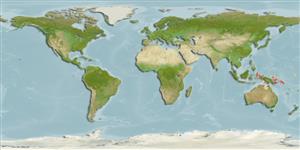>
Ovalentaria/misc (Various families in series Ovalentaria) >
Pseudochromidae (Dottybacks) > Pseudochrominae
Etymology: Pictichromis: Name from Latin pictus meaning painted or colored, and Greek Chromis, a genus of pomacentrid, used as the stem for other fish genera; alludes to the bright live colorations of the included species (Ref. 81967).
More on authors: Gill, Pyle & Earle.
Environment: milieu / climate zone / depth range / distribution range
Οικολογία
Θαλασσινό(ά) βενθικό(ς); εύρος βάθους 30 - 50 m (Ref. 90102). Tropical
Western Pacific: Papua New Guinea and Indonesia.
Μέγεθος / Βάρος / Age
Maturity: Lm ? range ? - ? cm
Max length : 4.0 cm SL αρσενικό/απροσδιόριστο; (Ref. 12721)
Ραχιαίες άκανθες (συνολικά) : 3; Μαλακές ραχιαίες ακτίνες (συνολικά) : 20 - 22; Εδρικές άκανθες: 3; Μαλακές εδρικές ακτίνες: 12.
Collected from coral and rubble slopes. Also found in reef slopes and dropoffs around overhangs and rocks in 30-50 m (Ref 90102).
Life cycle and mating behavior
Maturities | Αναπαραγωγή | Spawnings | Egg(s) | Fecundities | Προνύμφες
Gill, A.C., R.L. Pyle and J.L. Earle, 1996. Pseudochromis ephippiatus, new species of dottyback from southeastern Papua New Guinea (Teleostei: Perciformes: Pseudochromidae). Rev. Fr. Aquariol. 23(3-4):97-100. (Ref. 12721)
IUCN Red List Status (Ref. 130435)
Threat to humans
Harmless
Human uses
Εργαλεία
Special reports
Download XML
Διαδικτυακές πηγές
Estimates based on models
Preferred temperature (Ref.
123201): 26.4 - 27.8, mean 27.3 °C (based on 8 cells).
Phylogenetic diversity index (Ref.
82804): PD
50 = 0.5039 [Uniqueness, from 0.5 = low to 2.0 = high].
Bayesian length-weight: a=0.00490 (0.00187 - 0.01281), b=3.11 (2.88 - 3.34), in cm total length, based on LWR estimates for this (Sub)family-body shape (Ref.
93245).
Τροφικό Επίπεδο (Ref.
69278): 3.4 ±0.5 se; based on size and trophs of closest relatives
Fishing Vulnerability (Ref.
59153): Low vulnerability (10 of 100).
